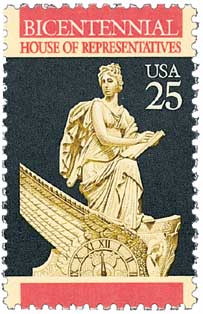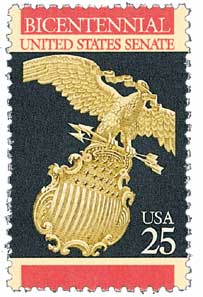
# 2421 PB - 1989 25c Constitution Bicentennial
25¢ Drafting of the Bill of Rights
City: Philadelphia, PA
Quantity: 191,860,000
Printed By: Bureau of Engraving and Printing
Printing Method: Lithographed and engraved
Perforations: 11
Color: Multicolored
Constitution Takes Effect

On March 4, 1789, the US Congress met for the first time under the terms of the recently ratified US Constitution.
In the spring of 1787, delegates from 12 of the 13 states (Rhode Island didn’t participate, as they opposed a national government) met at Independence Hall in Philadelphia to amend the Articles of Confederation. The Constitutional Convention opened on May 4.

The members of the convention ultimately drafted the new constitution based largely on the ideas of James Madison and signed it on September 17. In order for the proposed constitution to take effect, at least nine out of 13 states needed to ratify it. Five states ratified it that December, but some states, particularly Massachusetts, were unhappy with it. They felt the Constitution didn’t provide enough protection for freedom of speech, religion, the press, and the right to bear arms. In February 1788, they reached a compromise – those states would ratify the Constitution on the promise that amendments would be adopted to address their concerns. On June 21, 1788, New Hampshire became the ninth state to ratify the Constitution, making it legally binding.

On March 4, 1789, the Confederation Congress passed the power of the government over to the new US Congress operating under the Constitution. That day, the new Congress met for the first time at Federal Hall in New York City. During that session, James Madison also introduced the first draft of the Bill of Rights for consideration. But neither the House nor the Senate had enough members present to vote, and it would be a month before they all arrived. Finally, that September they agreed on the Bill of Rights and sent it to the states for ratification, which would take two years.

After this initial March 4 meeting, Congress moved the first day of business to December 1. However, March 4 would still hold special significance – it would be the last day of Congress’ two-year sessions. It would also be the day a new president was inaugurated. But as it turned out, this created some issues. Following a November election, Congress members that may have lost an election would have to continue to serve in a long “lame duck” session. On two occasions, lame-duck House sessions elected presidents (Thomas Jefferson in 1800 and John Quincy Adams in 1824). And in 1860, lame duck president James Buchanan and a divided Congress saw seven states secede from the Union after Abraham Lincoln was elected.

Eventually, the government realized the issues with the March 4 date. In 1933, they passed the 20th Amendment. This amendment set January 3 as the first day of a new Congress and January 20 as inauguration day for the president. It also stated the previous congressional and presidential terms would end just before the new ones began.
25¢ Drafting of the Bill of Rights
City: Philadelphia, PA
Quantity: 191,860,000
Printed By: Bureau of Engraving and Printing
Printing Method: Lithographed and engraved
Perforations: 11
Color: Multicolored
Constitution Takes Effect

On March 4, 1789, the US Congress met for the first time under the terms of the recently ratified US Constitution.
In the spring of 1787, delegates from 12 of the 13 states (Rhode Island didn’t participate, as they opposed a national government) met at Independence Hall in Philadelphia to amend the Articles of Confederation. The Constitutional Convention opened on May 4.

The members of the convention ultimately drafted the new constitution based largely on the ideas of James Madison and signed it on September 17. In order for the proposed constitution to take effect, at least nine out of 13 states needed to ratify it. Five states ratified it that December, but some states, particularly Massachusetts, were unhappy with it. They felt the Constitution didn’t provide enough protection for freedom of speech, religion, the press, and the right to bear arms. In February 1788, they reached a compromise – those states would ratify the Constitution on the promise that amendments would be adopted to address their concerns. On June 21, 1788, New Hampshire became the ninth state to ratify the Constitution, making it legally binding.

On March 4, 1789, the Confederation Congress passed the power of the government over to the new US Congress operating under the Constitution. That day, the new Congress met for the first time at Federal Hall in New York City. During that session, James Madison also introduced the first draft of the Bill of Rights for consideration. But neither the House nor the Senate had enough members present to vote, and it would be a month before they all arrived. Finally, that September they agreed on the Bill of Rights and sent it to the states for ratification, which would take two years.

After this initial March 4 meeting, Congress moved the first day of business to December 1. However, March 4 would still hold special significance – it would be the last day of Congress’ two-year sessions. It would also be the day a new president was inaugurated. But as it turned out, this created some issues. Following a November election, Congress members that may have lost an election would have to continue to serve in a long “lame duck” session. On two occasions, lame-duck House sessions elected presidents (Thomas Jefferson in 1800 and John Quincy Adams in 1824). And in 1860, lame duck president James Buchanan and a divided Congress saw seven states secede from the Union after Abraham Lincoln was elected.

Eventually, the government realized the issues with the March 4 date. In 1933, they passed the 20th Amendment. This amendment set January 3 as the first day of a new Congress and January 20 as inauguration day for the president. It also stated the previous congressional and presidential terms would end just before the new ones began.




